Alfa Romeo 4C 2020 Owner handbook (in English)
Manufacturer: ALFA ROMEO, Model Year: 2020, Model line: 4C, Model: Alfa Romeo 4C 2020Pages: 156, PDF Size: 3.06 MB
Page 51 of 156
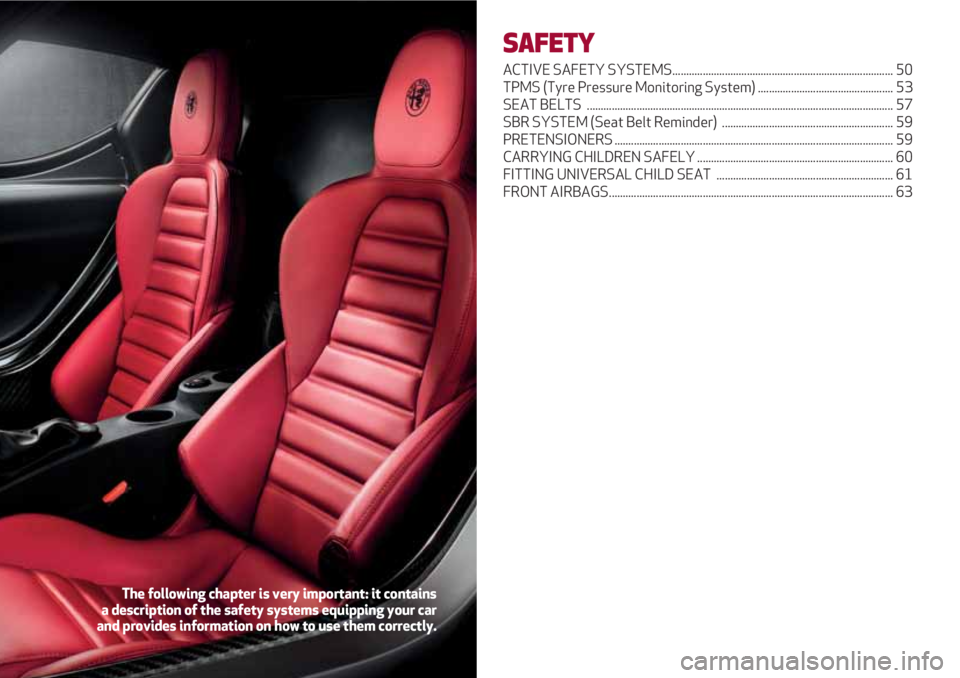
SAFETY
ACTIVE SAFETY SYSTEMS................................................................................ 50
TPMS (Tyre Pressure Monitoring System) ................................................. 53
SEAT BELTS ............................................................................................................... 57
SBR SYSTEM (Seat Belt Reminder) .............................................................. 59
PRETENSIONERS ..................................................................................................... 59
CARRYING CHILDREN SAFELY ....................................................................... 60
FITTING UNIVERSAL CHILD SEAT ................................................................ 61
FRONT AIRBAGS....................................................................................................... 63
The following chapter is very important: it contains
a description of the safety systems equipping your car
and provides information on how to use them correctly.
Page 52 of 156

SAFETY
50
ACTIVE SAFETY SYSTEMS
ABS SYSTEM
This system, which is an integral part of
the braking system, prevents one or
more wheels from locking and slipping in
all road surface conditions, irrespective
of the intensity of the braking action,
ensuring that the vehicle can be
controlled even during emergency
braking and optimising stopping
distances.
System intervention
The driver can feel that the ABS system
has come into action because the brake
pedal pulsates slightly and the system
gets noisier: this is entirely normal with
the system operating.
30) 31) 32) 33) 34) 35) 36)
ASR (AntiSlip Regulation) SYSTEM
37) 38) 39)
This is an integral part of the ESC system
and automatically operates in the event
of one or both drive wheels slipping, loss
of grip on wet roads (aquaplaning) and
acceleration on slippery, snowy or icy
roads, etc.
System intervention
The system intervenes on the engine
power and the brakes.
It is indicated by the flashing of the
warning light on the instrument panel,
to inform the driver that the vehicle is
in critical stability and grip conditions.
HBA (Hydraulic Brake Assist) SYSTEM
40) 41) 42)
The HBA system is designed to improve
the car’s braking capacity during
emergency braking: the HBA system
therefore completes the ABS system.
Maximum assistance from the HBA
system is obtained by continuously
pressing the brake pedal very quickly.
EBD SYSTEM
The EBD system is an integral part of the
ESC system and intervenes during
braking, distributing the brake force
optimally between front and rear wheels.
This guarantees greater braking stability
for the car, preventing sudden locking of
the rear wheels and the consequent
instability of the car.
DTC (Drag Torque Control) SYSTEM
This is an integral part of the ABS
system and intervenes in the case of
sudden downshifting, or during braking
when the ABS intervenes, restoring
torque to the engine and thus preventing
excessive drag at the drive wheels, which
may lead the wheels to lock and a loss of
car stability, above all in low-grip
conditions.
Page 53 of 156
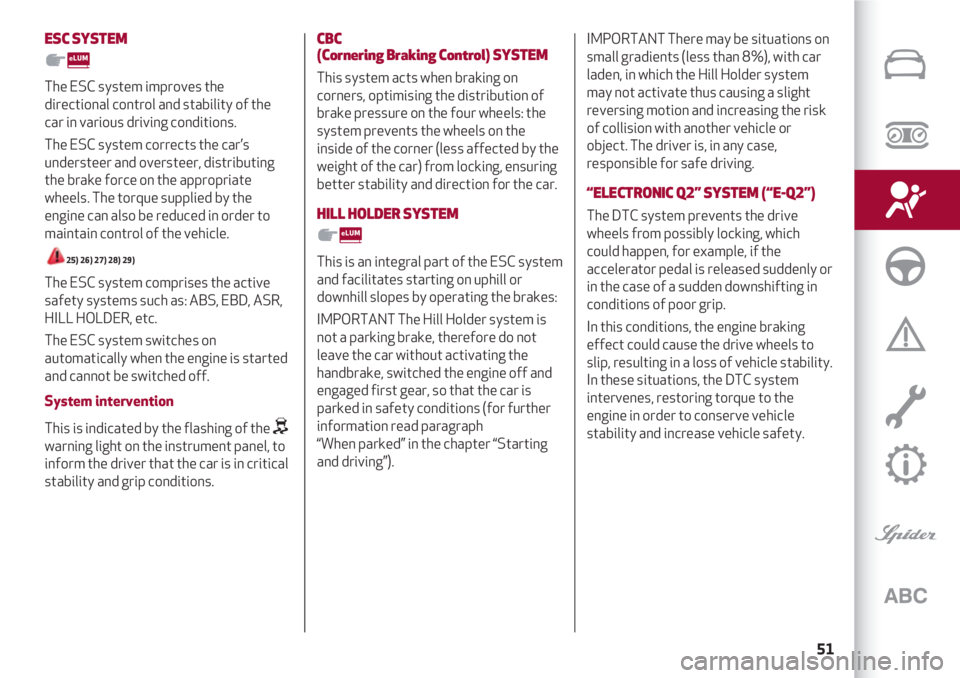
51
ESC SYSTEM
The ESC system improves the
directional control and stability of the
car in various driving conditions.
The ESC system corrects the car’s
understeer and oversteer, distributing
the brake force on the appropriate
wheels. The torque supplied by the
engine can also be reduced in order to
maintain control of the vehicle.
25) 26) 27) 28) 29)
The ESC system comprises the active
safety systems such as: ABS, EBD, ASR,
HILL HOLDER, etc.
The ESC system switches on
automatically when the engine is started
and cannot be switched off.
System intervention
This is indicated by the flashing of the
warning light on the instrument panel, to
inform the driver that the car is in critical
stability and grip conditions.
CBC
(Cornering Braking Control) SYSTEM
This system acts when braking on
corners, optimising the distribution of
brake pressure on the four wheels: the
system prevents the wheels on the
inside of the corner (less affected by the
weight of the car) from locking, ensuring
better stability and direction for the car.
HILL HOLDER SYSTEM
This is an integral part of the ESC system
and facilitates starting on uphill or
downhill slopes by operating the brakes:
IMPORTANT The Hill Holder system is
not a parking brake, therefore do not
leave the car without activating the
handbrake, switched the engine off and
engaged first gear, so that the car is
parked in safety conditions (for further
information read paragraph
“When parked” in the chapter “Starting
and driving”).
IMPORTANT There may be situations on
small gradients (less than 8%), with car
laden, in which the Hill Holder system
may not activate thus causing a slight
reversing motion and increasing the risk
of collision with another vehicle or
object. The driver is, in any case,
responsible for safe driving.
“ELECTRONIC Q2” SYSTEM (“E-Q2”)
The DTC system prevents the drive
wheels from possibly locking, which
could happen, for example, if the
accelerator pedal is released suddenly or
in the case of a sudden downshifting in
conditions of poor grip.
In this conditions, the engine braking
effect could cause the drive wheels to
slip, resulting in a loss of vehicle stability.
In these situations, the DTC system
intervenes, restoring torque to the
engine in order to conserve vehicle
stability and increase vehicle safety.
Page 54 of 156

SAFETY
52
“PRE-FILL” SYSTEM
(RAB - Ready Alert Brake)
(only with “Dynamic” mode engaged)
This function activates automatically if
the accelerator pedal is released rapidly,
reducing the brake pad travel (both at
front and back), with the aim of preparing
the braking system and enhancing its
responsiveness, thus reducing the
stopping distance in the event of
subsequent braking.
25)The ESC system cannot alter the
natural laws of physics, and cannot
increase grip, which depends on the
condition of the road.
26)The ESC system cannot prevent
accidents, including those due to
excessive speed on corners, driving on
low-grip surfaces or aquaplaning.
27)The capability of the ESC system
must never be tested irresponsibly and
dangerously, in such a way as to
compromise personal safety and the
safety of others.
28)For the correct operation of the ASR
system, the tyres must of necessity be
the same make and type on all wheels, in
perfect condition and, above all, of the
prescribed type and dimensions.
IMPORTANT
29)Do not take unnecessary risks, even if
your vehicle is fitted with the ESC and
ASR systems.
Your driving style must always be suited
to the road conditions, visibility and
traffic.
The driver is always responsible for road
safety.
30)When the ABS intervenes and you
notice the brake pedal pulsating, do not
reduce the pressure, but hold it firmly and
confidently; in doing so you will brake in
the shortest distance possible, depending
on the road conditions.
31)For maximum efficiency of the
braking system, a bedding-in period of
about 500 km is needed: during this
period it is better to avoid sharp,
repeated and prolonged braking.
32)If the ABS intervenes, this indicates
that the grip of the tyres on the road is
nearing its limit: you must slow down to a
speed compatible with the available grip.
33)The ABS cannot overrule the natural
laws of physics, and cannot increase the
grip available according to the condition
of the road.
34)The ABS cannot prevent accidents,
including those due to excessive speed on
corners, driving on low-grip surfaces or
aquaplaning.35) The capability of the ABS must never
be tested irresponsibly and dangerously,
in such a way as to compromise personal
safety and the safety of others.
36)For the correct operation of the ABS,
the tyres must of necessity be the same
make and type on all wheels, in perfect
condition and, above all, of the prescribed
type and dimensions.
37)The ASR cannot overrule the natural
laws of physics, and cannot increase the
grip available according to the condition
of the road.
38)The ASR system cannot prevent
accidents, including those due to
excessive speed on corners, driving on
low-grip surfaces or aquaplaning.
39) The capability of the ASR must never
be tested irresponsibly and dangerously,
in such a way as to compromise personal
safety and the safety of others.
40)The HBA system can’t overrule the
natural laws of physics, and can’t increase
the grip available according to the
condition of the road.
41)The HBA system cannot prevent
accidents, including those due to
excessive speed on corners, driving on
low-grip surfaces or aquaplaning.
42) The capability of the HBA system
must never be tested irresponsibly and
dangerously, in such a way as to
compromise the safety of the driver, the
other occupants of the vehicle or any
other road user.
Page 55 of 156
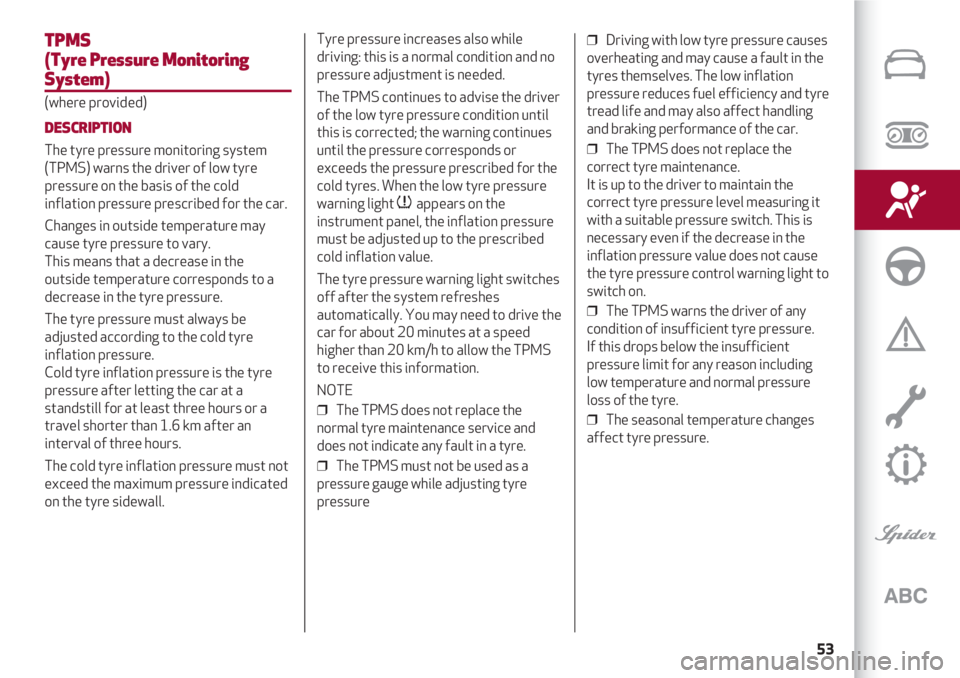
53
TPMS
(Tyre Pressure Monitoring
System)
(where provided)
DESCRIPTION
The tyre pressure monitoring system
(TPMS) warns the driver of low tyre
pressure on the basis of the cold
inflation pressure prescribed for the car.
Changes in outside temperature may
cause tyre pressure to vary.
This means that a decrease in the
outside temperature corresponds to a
decrease in the tyre pressure.
The tyre pressure must always be
adjusted according to the cold tyre
inflation pressure.
Cold tyre inflation pressure is the tyre
pressure after letting the car at a
standstill for at least three hours or a
travel shorter than 1.6 km after an
interval of three hours.
The cold tyre inflation pressure must not
exceed the maximum pressure indicated
on the tyre sidewall.Tyre pressure increases also while
driving: this is a normal condition and no
pressure adjustment is needed.
The TPMS continues to advise the driver
of the low tyre pressure condition until
this is corrected; the warning continues
until the pressure corresponds or
exceeds the pressure prescribed for the
cold tyres. When the low tyre pressure
warning light
nappears on the
instrument panel, the inflation pressure
must be adjusted up to the prescribed
cold inflation value.
The tyre pressure warning light switches
off after the system refreshes
automatically. You may need to drive the
car for about 20 minutes at a speed
higher than 20 km/h to allow the TPMS
to receive this information.
NOTE
❒ The TPMS does not replace the
normal tyre maintenance service and
does not indicate any fault in a tyre.
❒ The TPMS must not be used as a
pressure gauge while adjusting tyre
pressure❒ Driving with low tyre pressure causes
overheating and may cause a fault in the
tyres themselves. The low inflation
pressure reduces fuel efficiency and tyre
tread life and may also affect handling
and braking performance of the car.
❒ The TPMS does not replace the
correct tyre maintenance.
It is up to the driver to maintain the
correct tyre pressure level measuring it
with a suitable pressure switch. This is
necessary even if the decrease in the
inflation pressure value does not cause
the tyre pressure control warning light to
switch on.
❒ The TPMS warns the driver of any
condition of insufficient tyre pressure.
If this drops below the insufficient
pressure limit for any reason including
low temperature and normal pressure
loss of the tyre.
❒ The seasonal temperature changes
affect tyre pressure.
Page 56 of 156
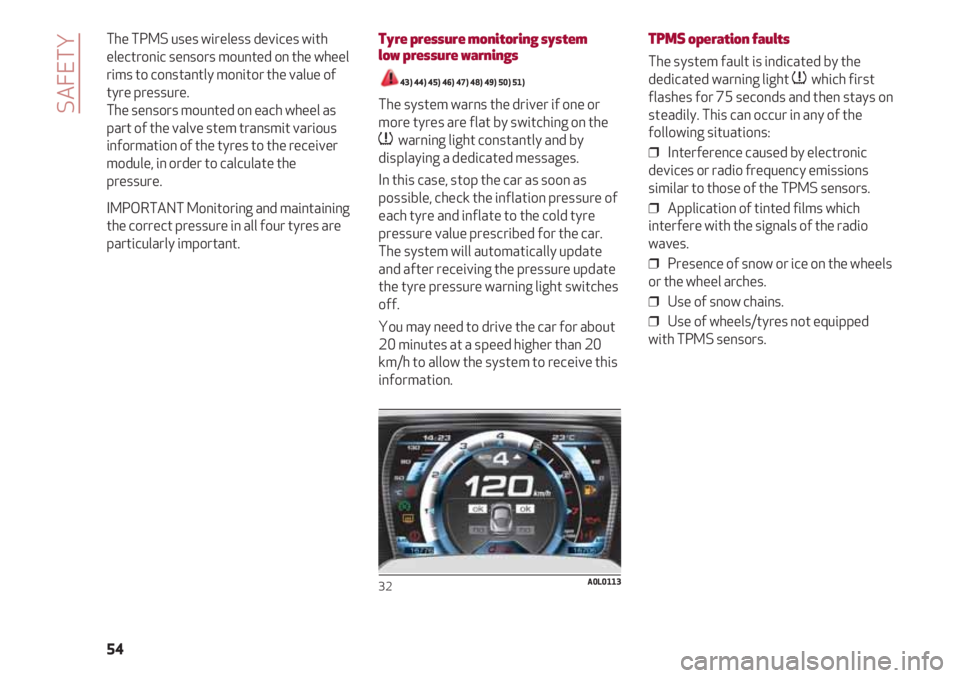
SAFETY
54 The TPMS uses wireless devices with
electronic sensors mounted on the wheel
rims to constantly monitor the value of
tyre pressure.
The sensors mounted on each wheel as
part of the valve stem transmit various
information of the tyres to the receiver
module, in order to calculate the
pressure.
IMPORTANT Monitoring and maintaining
the correct pressure in all four tyres are
particularly important.
Tyre pressure monitoring system
low pressure warnings
43) 44) 45) 46) 47) 48) 49) 50) 51)
The system warns the driver if one or
more tyres are flat by switching on the
nwarning light constantly and by
displaying a dedicated messages.
In this case, stop the car as soon as
possible, check the inflation pressure of
each tyre and inflate to the cold tyre
pressure value prescribed for the car.
The system will automatically update
and after receiving the pressure update
the tyre pressure warning light switches
off.
You may need to drive the car for about
20 minutes at a speed higher than 20
km/h to allow the system to receive this
information.
32A0L0113
TPMS operation faults
The system fault is indicated by the
dedicated warning light
nwhich first
flashes for 75 seconds and then stays on
steadily. This can occur in any of the
following situations:
❒ Interference caused by electronic
devices or radio frequency emissions
similar to those of the TPMS sensors.
❒ Application of tinted films which
interfere with the signals of the radio
waves.
❒ Presence of snow or ice on the wheels
or the wheel arches.
❒ Use of snow chains.
❒ Use of wheels/tyres not equipped
with TPMS sensors.
Page 57 of 156
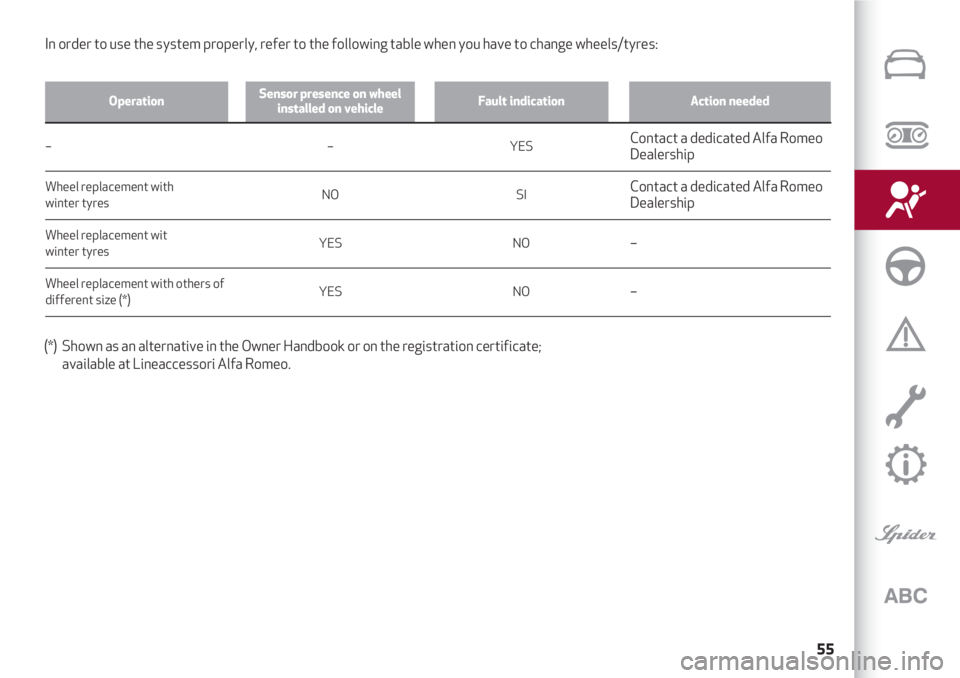
55
OperationSensor presence on wheel
installed on vehicleFault indicationAction needed
–
Wheel replacement with
winter tyres
Wheel replacement wit
winter tyres
Wheel replacement with others of
different size (*)–
NO
YES
YESYES
SI
NO
NOContact a dedicated Alfa Romeo
Dealership
Contact a dedicated Alfa Romeo
Dealership
–
–
(*) Shown as an alternative in the Owner Handbook or on the registration certificate;
available at Lineaccessori Alfa Romeo. In order to use the system properly, refer to the following table when you have to change wheels/tyres:
Page 58 of 156
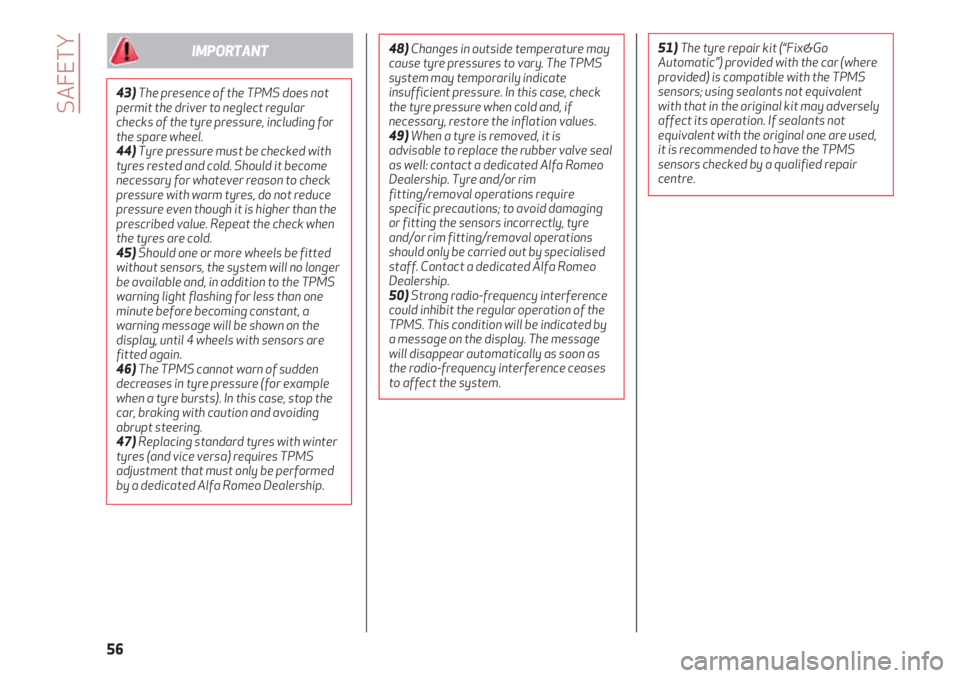
SAFETY
56
43)The presence of the TPMS does not
permit the driver to neglect regular
checks of the tyre pressure, including for
the spare wheel.
44)Tyre pressure must be checked with
tyres rested and cold. Should it become
necessary for whatever reason to check
pressure with warm tyres, do not reduce
pressure even though it is higher than the
prescribed value. Repeat the check when
the tyres are cold.
45)Should one or more wheels be fitted
without sensors, the system will no longer
be available and, in addition to the TPMS
warning light flashing for less than one
minute before becoming constant, a
warning message will be shown on the
display, until 4 wheels with sensors are
fitted again.
46)The TPMS cannot warn of sudden
decreases in tyre pressure (for example
when a tyre bursts). In this case, stop the
car, braking with caution and avoiding
abrupt steering.
47)Replacing standard tyres with winter
tyres (and vice versa) requires TPMS
adjustment that must only be performed
by a dedicated Alfa Romeo Dealership.
IMPORTANT48)Changes in outside temperature may
cause tyre pressures to vary. The TPMS
system may temporarily indicate
insufficient pressure. In this case, check
the tyre pressure when cold and, if
necessary, restore the inflation values.
49)When a tyre is removed, it is
advisable to replace the rubber valve seal
as well: contact a dedicated Alfa Romeo
Dealership. Tyre and/or rim
fitting/removal operations require
specific precautions; to avoid damaging
or fitting the sensors incorrectly, tyre
and/or rim fitting/removal operations
should only be carried out by specialised
staff. Contact a dedicated Alfa Romeo
Dealership.
50)Strong radio-frequency interference
could inhibit the regular operation of the
TPMS. This condition will be indicated by
a message on the display. The message
will disappear automatically as soon as
the radio-frequency interference ceases
to affect the system.51)The tyre repair kit (“Fix&Go
Automatic”) provided with the car (where
provided) is compatible with the TPMS
sensors; using sealants not equivalent
with that in the original kit may adversely
affect its operation. If sealants not
equivalent with the original one are used,
it is recommended to have the TPMS
sensors checked by a qualified repair
centre.
Page 59 of 156
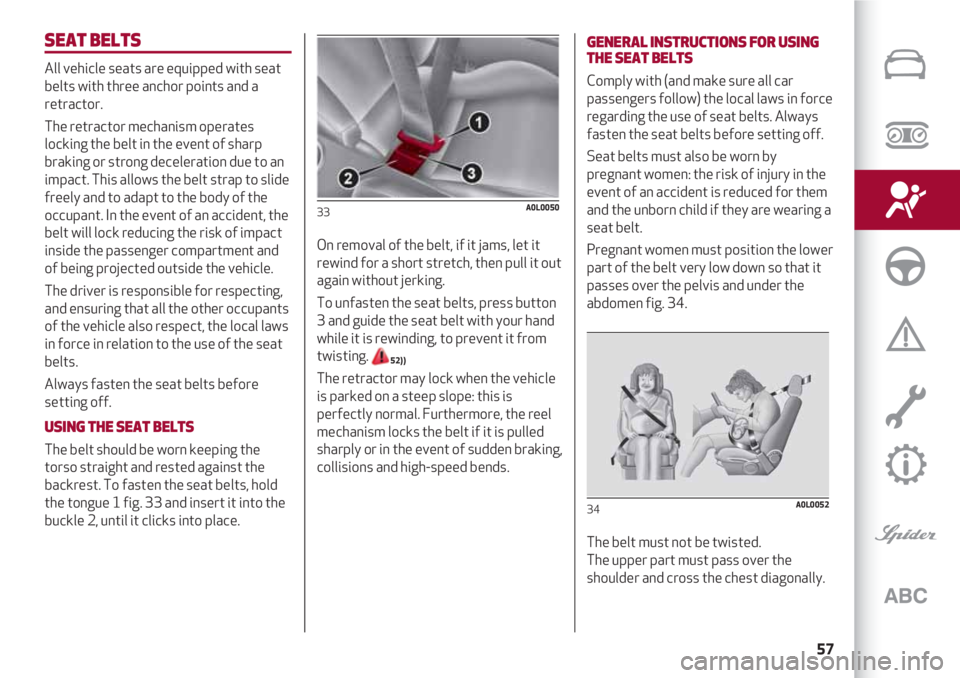
57
SEAT BELTS
All vehicle seats are equipped with seat
belts with three anchor points and a
retractor.
The retractor mechanism operates
locking the belt in the event of sharp
braking or strong deceleration due to an
impact. This allows the belt strap to slide
freely and to adapt to the body of the
occupant. In the event of an accident, the
belt will lock reducing the risk of impact
inside the passenger compartment and
of being projected outside the vehicle.
The driver is responsible for respecting,
and ensuring that all the other occupants
of the vehicle also respect, the local laws
in force in relation to the use of the seat
belts.
Always fasten the seat belts before
setting off.
USING THE SEAT BELTS
The belt should be worn keeping the
torso straight and rested against the
backrest. To fasten the seat belts, hold
the tongue 1 fig. 33 and insert it into the
buckle 2, until it clicks into place.On removal of the belt, if it jams, let it
rewind for a short stretch, then pull it out
again without jerking.
To unfasten the seat belts, press button
3 and guide the seat belt with your hand
while it is rewinding, to prevent it from
twisting.
52))
The retractor may lock when the vehicle
is parked on a steep slope: this is
perfectly normal. Furthermore, the reel
mechanism locks the belt if it is pulled
sharply or in the event of sudden braking,
collisions and high-speed bends.
33A0L0050
GENERAL INSTRUCTIONS FOR USING
THE SEAT BELTS
Comply with (and make sure all car
passengers follow) the local laws in force
regarding the use of seat belts. Always
fasten the seat belts before setting off.
Seat belts must also be worn by
pregnant women: the risk of injury in the
event of an accident is reduced for them
and the unborn child if they are wearing a
seat belt.
Pregnant women must position the lower
part of the belt very low down so that it
passes over the pelvis and under the
abdomen fig. 34.
The belt must not be twisted.
The upper part must pass over the
shoulder and cross the chest diagonally.
34A0L0052
Page 60 of 156
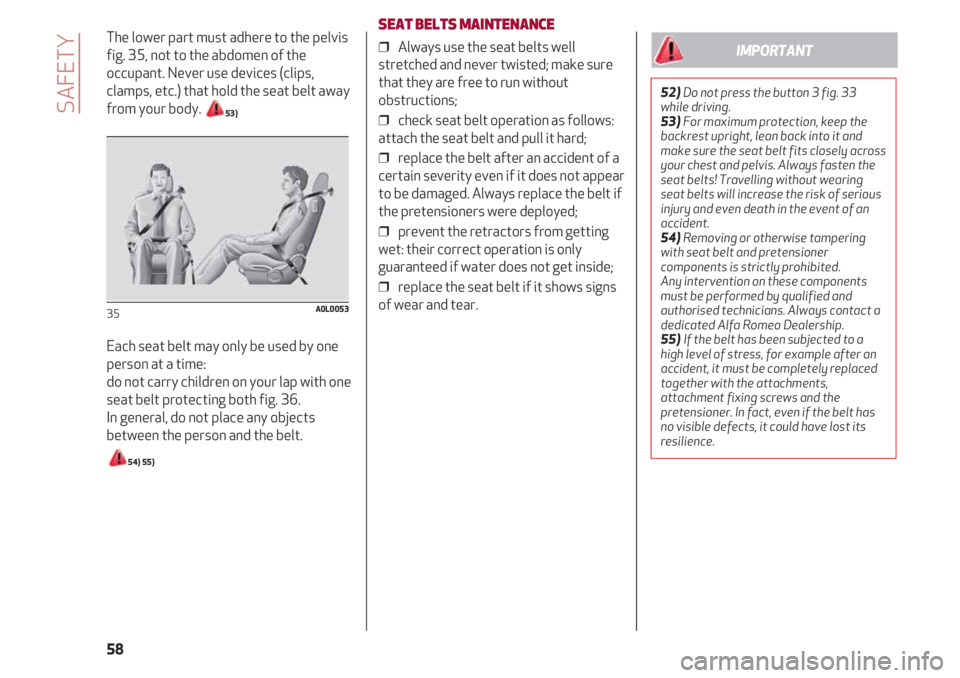
SAFETY
58
The lower part must adhere to the pelvis
fig. 35, not to the abdomen of the
occupant. Never use devices (clips,
clamps, etc.) that hold the seat belt away
from your body.
53)
Each seat belt may only be used by one
person at a time:
do not carry children on your lap with one
seat belt protecting both fig. 36.
In general, do not place any objects
between the person and the belt.
54) 55)
35A0L0053
SEAT BELTS MAINTENANCE
❒ Always use the seat belts well
stretched and never twisted; make sure
that they are free to run without
obstructions;
❒ check seat belt operation as follows:
attach the seat belt and pull it hard;
❒ replace the belt after an accident of a
certain severity even if it does not appear
to be damaged. Always replace the belt if
the pretensioners were deployed;
❒ prevent the retractors from getting
wet: their correct operation is only
guaranteed if water does not get inside;
❒ replace the seat belt if it shows signs
of wear and tear.
52)Do not press the button 3 fig. 33
while driving.
53)For maximum protection, keep the
backrest upright, lean back into it and
make sure the seat belt fits closely across
your chest and pelvis. Always fasten the
seat belts! Travelling without wearing
seat belts will increase the risk of serious
injury and even death in the event of an
accident.
54)Removing or otherwise tampering
with seat belt and pretensioner
components is strictly prohibited.
Any intervention on these components
must be performed by qualified and
authorised technicians. Always contact a
dedicated Alfa Romeo Dealership.
55) If the belt has been subjected to a
high level of stress, for example after an
accident, it must be completely replaced
together with the attachments,
attachment fixing screws and the
pretensioner. In fact, even if the belt has
no visible defects, it could have lost its
resilience.
IMPORTANT